3-D Genesis
|
Name:
|
3-D Genesis
|
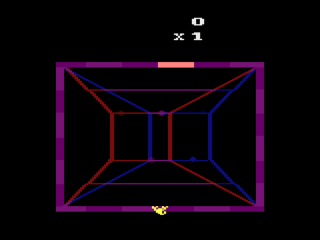
|
| Company: |
Amiga |
|
Model #:
|
N/A |
|
Programmers:
|
Dan McElroy and Jerry
Lawson (Videosoft) |
| Year: |
1983
|
|
Released?
|
No
|
|
Notes:
|
Port of
unreleased 1983 arcade game by Design Lab
|
According to the manual that came with the
reproduction sold a few years back, it is the far future
and the planet has been overrun by enormous super
insects (sounds like a bad 50’s B-movie). However
in an aversion to the standard plots of the time, you
are not a lone hero out to save the world from these
deadly insects. Instead, you ARE one of those
insects! You goal is to destroy all the insects
who are invading your crevice and win the battle for the
planet.
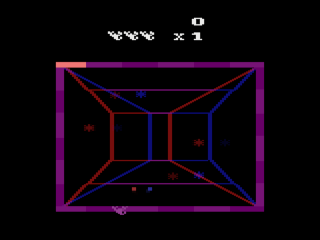
You control a scorpion (technically
scorpions are arachnids not insects, but we’ll cut the
programmer some slack) who must move around the outside
of a three dimensional cube shooting all the incoming
spiders (once again, not an insect!). If a spider
reaches the edge of the cube it has a chance of knocking
out a piece of it creating a hole, otherwise it will go
back down to the center again. If you accidentally
touch a hole that a spider created or the spider itself
you will lose a life. After shooting specific
number of spiders you will go to the next more difficult
wave (eight in all).
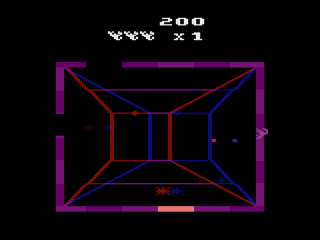
Speaking of the cube edge, you’ll undoubtedly
notice a yellow bar that slowly moves around. This
is the ‘rail snail’ (also not an insect), and like most
snails he’s deadly to the touch (well ok, not like most
snails. Cut me some slack here). However
every now and then the rail snail will decide to change
direction (the snail will flash and emit a short sound
when this happens). If you happen to move over the
snail during this brief time window you’ll not only gain
10 points, but increase the point multiplier, gain a
onetime immunity from touching the snail, AND be able to
repair one hole in the cube (simply touch it to fill it
in). Not a bad deal for running over a dimwitted
mollusk. However you’ve got to be quick because the
time window for doing this is pretty short.
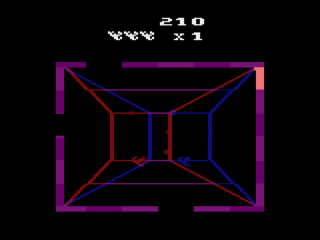
Other than being a pretty decent Tempest rip-off
(admittedly with some new elements thrown in), the main
draw of the game is the 3-D effect. Attempting to
play the game without the benefit of red/blue glasses is
nearly impossible as the screen is constantly switching
back and forth between red and blue frames that make up
the 3-D perspective. Even with the proper glasses,
the 3-D effect is pretty bad as the 2600 just doesn’t
have the resolution to do it properly. Still, it
would have been a decent gimmick at the time and
probably sold pretty well given 3-D’s brief resurgence
in popularity at the time. The 3-D effect can be
turned on and off with the Color/B&W switch, making
the game playable by those without the special
glasses.
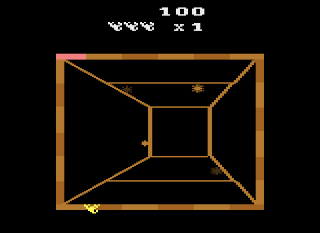
For the longest time it was assumed that 3-D
Genesis was an original game designed by Videosoft.
However upon further investigation it was discovered that
the 2600 version is actually a port of an unreleased
arcade game by Design Labs. No one really knows much
about Design Labs or the arcade version of Genesis, but
somehow Datasoft got the home computer rights and released
ports for the Apple II, Atari 8-bit, C-64, and the PC
(which also went unreleased due to being incompatible with
the PCjr). It's unknown how Amiga got the game
console rights, but the 2600 appears to be the only
platform they targeted.
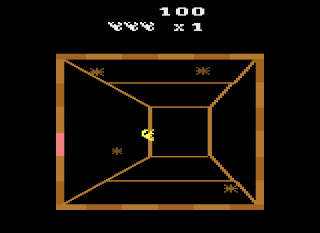
The history of 3-D Genesis is a bit confusing.
Originally planned to be a cassette based game for the
Amiga Power Module it was then moved to the Power Play
Arcade series of multicarts (see this
page for more information). 3-D Genesis
would have been teamed up with 3-D Ghost Attack and 3-D
Havoc on Power Play Arcade cart #1 (5 carts were planned
in total). It’s unknown why Amiga decided to put
three full games on one cart as any one of these games
could have stood on their own, but it would have been a
real deal for the penny conscious gamer. Perhaps
Amiga knew that the market was becoming cluttered and
thought that offering several games on one cartridge was
a way to stand out from the crowd (Xonox did something
similar with their double enders). Whatever the
reason it was all for naught as the project was
cancelled before getting out the door due to Amiga’s
decision to stop with the games and focus on a little
computer that they’d been developing instead...
| Version |
Cart Text |
Description |
| ?/??/83 |
|
Only known copy
|
Return
to 2600 Software
|






